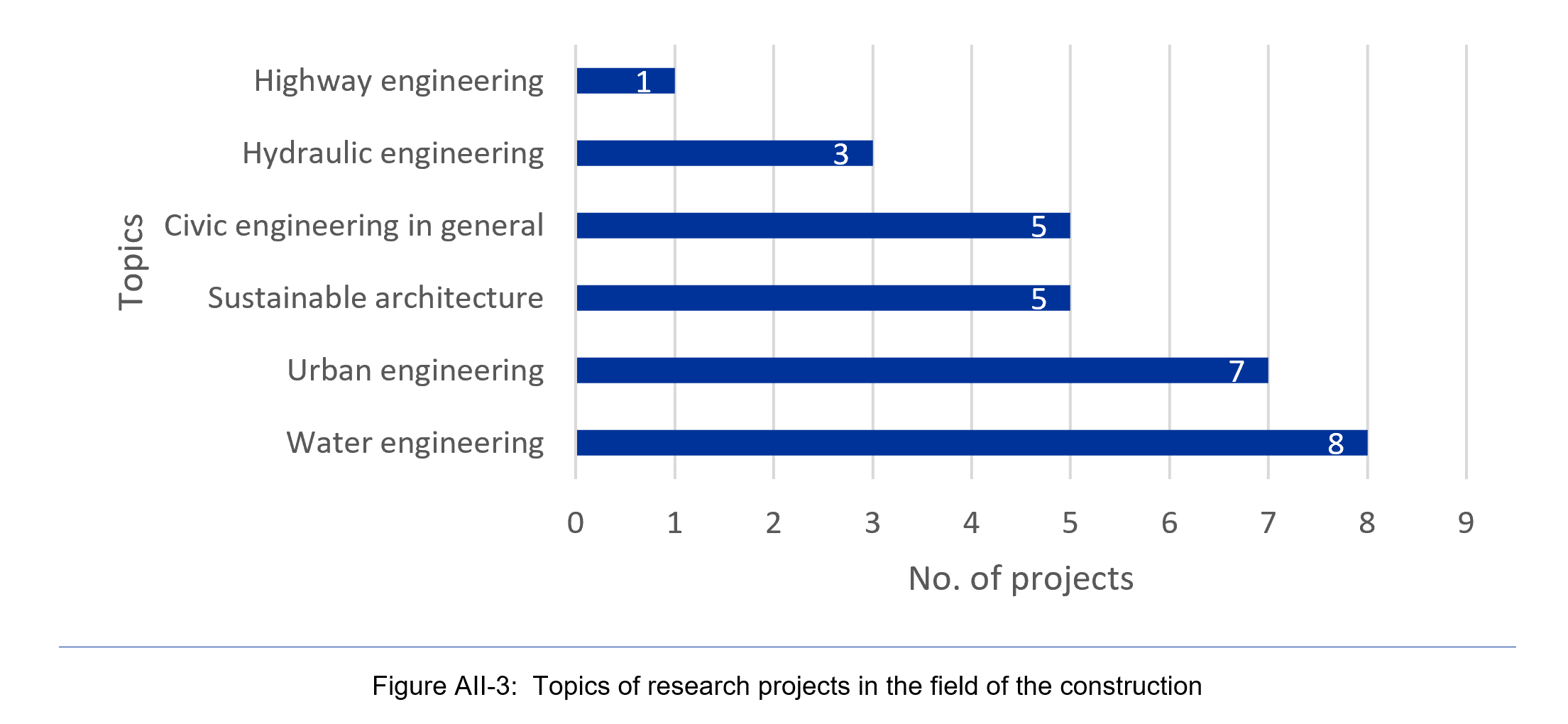R&D - EUON
Construction
This section gives an overview of the Horizon 2020 projects focused on construction. In research classification used by Cordis database, construction corresponds to the discipline of civil engineering. In Cordis classification, civil engineering covers both buildings and other public infrastructure.
The projects that contained the keyword “civil engineering” in their subject classification were filtered out from the general collection of nanotechnology projects developed for the study.
In the period of 2017-2020, Horizon 2020 funded 29 projects in the field of construction. The construction projects comprised 2% of all research projects in nanotechnology funded by the EU in 2017-2020. In general, it shows that the interest in nanotechnology and the environment was low.
Analysis of the start date of construction projects shows that most of them received funding and started in 2017 and 2018. H2020 covered the 2014-2020 period, so with 2017 as a mid-term of the programme, it is not surprising that most projects started during this period. The decreasing number of research projects towards the end of the funding period is explained by the fact that most research projects require several years to complete.

H2020 contained several high-level programmes/priorities/specific actions and their sub-programmes. Three thematic and two horizontal high-level programmes funded nanotechnology research and innovation:
- Priority “Excellent science” (1) aimed to improve the excellence of the European research base and consolidate the European Research Area (ERA) to increase the global competitiveness of European research and innovation.
- Priority “Industrial leadership” (2) focused on boosting the development of the technologies and innovations that will underpin future businesses and help innovative European SMEs to grow into world-leading companies. This priority contained a sub-programme targeted at nanotechnologies.
- Priority “Societal challenges” (3) focused on the societal challenges that were identified in the Europe 2020 strategy and aimed to encourage sufficient research and innovation efforts necessary to cope with these challenges and achieve the EU strategic goals.
- Specific objective “Spreading excellence and widening participation” (4) was a horizontal objective of Horizon 2020 aimed at pooling research and innovation talents in Europe, nurturing and connecting pools of excellence to maximise and fully exploit Europe’s research and innovation potential.
- Specific objective “Science with and for society” (5) was a horizontal objective of Horizon 2020 aimed at strengthening the collaboration between science and society by engaging citizens in science and using collective intelligence for solving research problems, promoting scientific careers, etc.
Each of the described high-level programmes contained the whole hierarchy of sub-programmes. Usually, one project received funding through a combination of programmes. Those combinations of (sub)programmes from 2017-2020 were filtered out. Figure 9 gives an overview of programmes and subprogrammes that funded construction research under Horizon 2020.

Between 2017-2020, Horizon 2020 construction research projects were more focused on industrial innovation than scientific excellence. Most construction projects received funding under the priority “Industrial leadership” and its subprogrammes (20 projects, 69%) that promoted nanotechnology innovation and commercialisation. These subprogrammes were focused on building the capacity of individual researchers and their teams as well as encouraging collaboration between researchers. Substantially less, 10 projects (35%), were funded under the third priority “Social challenges” and the priority “Scientific excellence” (7 projects, 24%). Finally, three projects (10%) were focused on the horizontal objective “Spreading excellence and widening participation” and only two projects (7%) – on the horizontal objective “Science with and for society”.
According to the project classification applied in Cordis, construction projects focused on six topics. One project could combine several topics. In most cases, projects used classes referring to different hierarchical classification levels. For instance, some projects referred to “civic engineering” in general, while others specified the focus on specific issues of civic engineering, such as water engineering, urban engineering, etc.

Most projects focused on water engineering (8 projects, 28%) and urban engineering (7 projects, 24%). Other topics addressed civil engineering in general (5 projects, 17%) and sustainable architecture (5 projects, 17%) issues. Hydraulic engineering (3 projects, 10%) and highway engineering (1 project, 3%) received little attention. An illustrative example of a project focused on the water engineering is provided in the table below.
| Table AII-1: An example of a project focused on water engineering | |||
|---|---|---|---|
| Project title, acronym, (coordinating country) |
Objectives | Start, end dates | Funding (EU contribution) |
| Smart anticorrosion coatings based on nanocontainers loaded with novel, eco-friendly cationic gemini surfactants as efficient corrosion inhibitors for carbon steel in seawater, EcoGemCoat (Portugal) | The project, EcoGemCoat, involves the preparation of smart anticorrosion coatings based on mesoporous silica nanocontainers loaded with innovative, eco-friendly cationic gemini surfactants as high efficient corrosion inhibitors of carbon steel in seawater with the potential application in marine and offshore industry. The main aim of EcoGemCoat will be achieved by performing four specific goals: 1) preparation of novel corrosion inhibitors (synthesis of the surfactants and structure confirmation) with low toxicity; 2) testing of the inhibitors (aggregation behaviour tests, biological tests, electrochemical corrosion inhibition tests); 3) preparation of smart coatings (immobilization of surfactants, characterization of nanocontainers, release study, smart coating preparation); 4) corrosion, mechanical and biological tests of the developed coatings. |
2018-2020 | € 148 635,60 |


